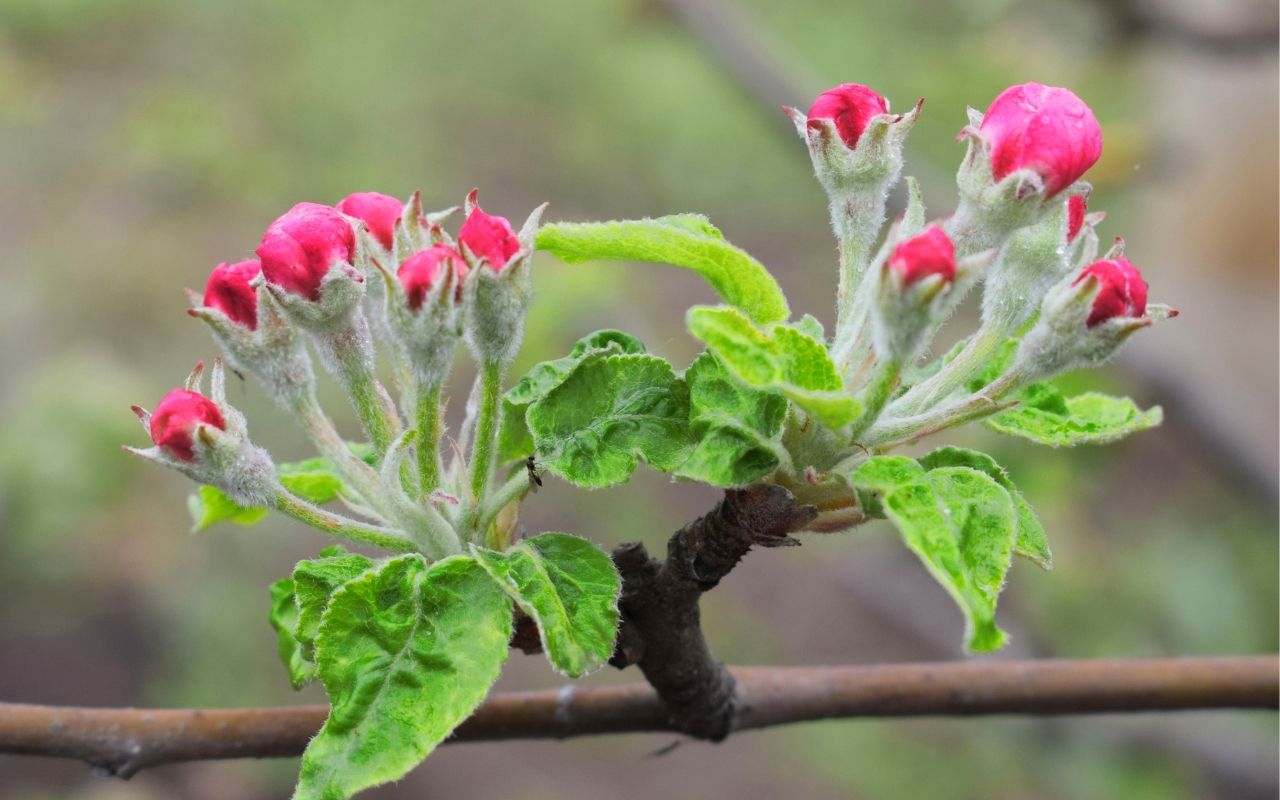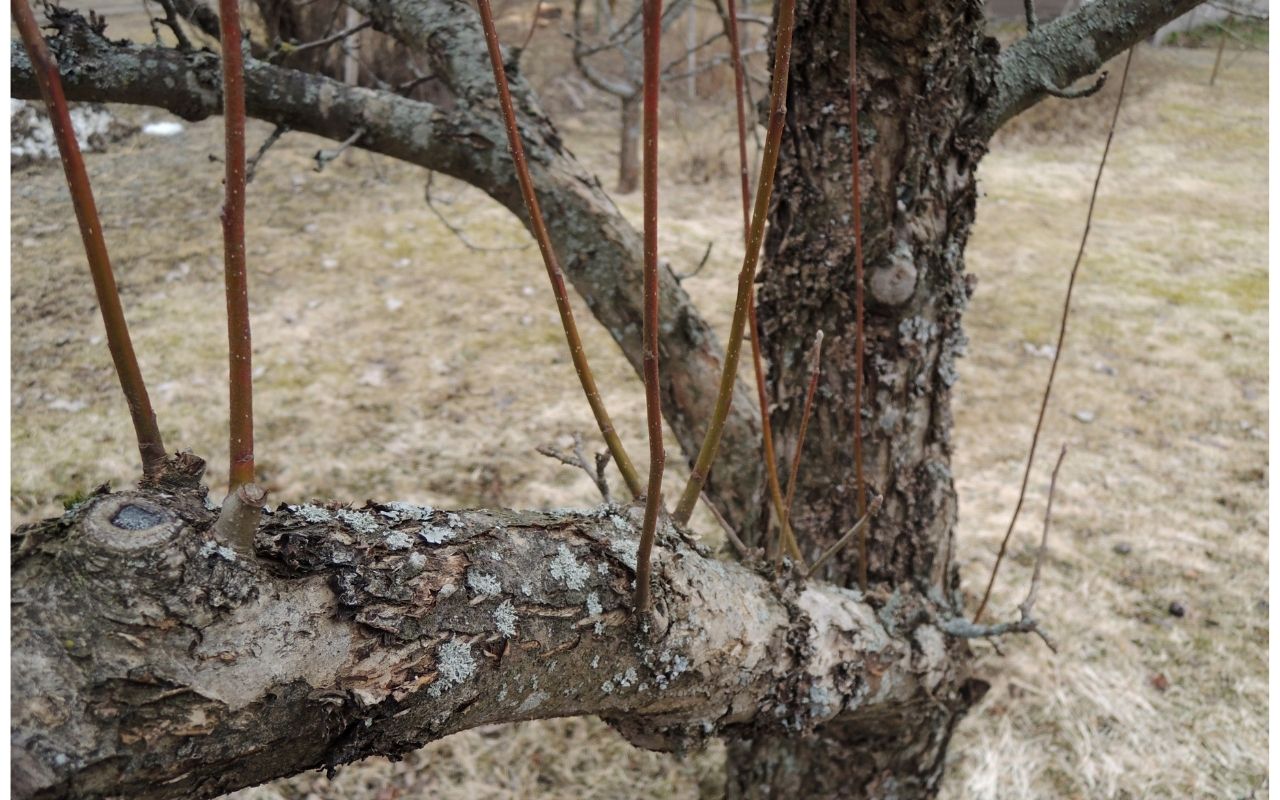To enjoy a bountiful harvest of vibrant spring flowers and juicy summer fruit, it’s important to keep your fruit trees healthy and strong. The best way to help them thrive lies in proper pruning. Unsure when or how to prune your fruit trees for the best results? Don’t worry – we’ll explain everything you need to know about fruit tree pruning.
PRO TIP: Want to learn more about growing fruit trees in Northern Virginia? Read some of our previous articles on nurturing young fruit trees:
Key Takeaways
- Pruning fruit trees regularly is important for their health, encouraging better airflow, sunlight, and fruit production.
- The best time to prune most fruit trees is during the dormant season, especially late winter, for the best results.
- Pruning in summer should be minimal, focusing on removing water sprouts to prevent energy waste and encourage fruit growth.
- Identifying the difference between old and new wood is necessary for successful pruning, especially for trees that produce fruit on spurs.
- If you’re unsure about pruning techniques, it’s always a good idea to seek help from a professional arborist to ensure the best care for your trees.
Reasons to Prune Fruit Trees
We have a diverse ecosystem in Northern Virginia. Some areas are more rural (such as Fairfax Station), while others have a suburban and city feel (like Alexandria). Regardless of where you live, the trees in our area benefit from regular pruning. Fruit trees, in particular, need regular – and proper – pruning.
Some of the benefits of pruning fruit trees include:
- Open Up the Tree Canopy: Fruit needs sunlight to ripen. Proper pruning removes branches and leaves that shade out developing fruit while maintaining enough leaves to generate the energy for fruit growth.
- Improve Airflow Through the Canopy: Many types of fruit are susceptible to fungal problems. Increasing airflow through the tree canopy by removing excess branches and leaves can reduce the risk of fungi.
- Create and Maintain Structure: Proper pruning will create a tree that allows for easy access to fruit while also being structurally sound.
- Minimize the Growth of Water Sprouts: Water sprouts are thin, spindly, upward-growing branches that quickly grow in response to fruit tree pruning. These growths drain energy from the tree (so it produces fewer fruits), block sunlight and airflow through the center of the tree (leading to fungal problems and unripe fruit), and can cause damage to other branches by rubbing against them. Proper fruit tree pruning done at the right time of year can minimize or remove water sprouts.
- Encourage the Growth of More Fruit: When done correctly, pruning encourages a plentiful supply of new fruit-bearing limbs (not water sprouts!)
When to Prune Fruit Trees
You can prune commonly grown Northern Virginia fruit trees (such as apple, pear, or cherry) at any time of year, especially if there is a structural problem or damage. However, there are a few things to keep in mind during different seasons.
Prune Fruit Trees in the Winter for the Best Results
Fruit trees grow in concert with the year’s annual cycles. From their first spring flowers to their last dropped autumn leaf, trees respond to changes in temperature and hours of daily sunlight. After you’ve picked all the fruit and raked up the leaves, trees begin to enter dormancy (think of it like a bear hibernating).
What all fruit trees have in common is that the best time to prune them is during the dormant season, with late winter being ideal. Some of the benefits of winter pruning include:
- Better visibility of a tree’s structure
- No risk of insect or disease infections
- Less stress for your trees
PRO TIP: Winter, particularly late winter and early spring, is the best time to prune most trees for optimal health and growth. For expert insights, check out our detailed guide on winter pruning.
Fruit Tree Pruning in Spring
Avoid pruning too much in the spring. Removing excess branches can lead to sap loss and reduce your fruit yields. Instead, try to finish all your fruit tree pruning before winter ends.
Fruit Tree Pruning in Summer
Summer is the peak growing season for trees, with leaves playing an important role in photosynthesis and fueling the tree’s growth. Pruning too heavily during this time can hinder fruit production by reducing the tree’s ability to photosynthesize and generate the energy it needs.
That’s not to say you shouldn’t do any pruning in the summer. Summer is perfect for removing water sprouts from your tree. These branches will not produce fruit and will siphon energy the tree could use for fruit production.
Fruit Tree Pruning in Fall
We do not recommend pruning fruit trees in the fall. Fall pruning causes a tree to put out new growth in response to stress. The new growth is weak, and the cold winter temperatures will likely kill it.
The only pruning we recommend you do in the fall is to remove any dead, broken, or diseased branches.
What to Prune
No matter what you’re cutting off, always remember this important rule about pruning: all pruning should be minimal, removing only what is required. One of the benefits of regular pruning throughout a tree’s life is you only take a small number of branches each time. This is better than significant pruning once in a blue moon that removes too many branches.
PRO TIP: Pruning and tree care can be risky when not handled by a professional. Learn more about the potential dangers and when to seek expert help with our articles on:
Old Wood vs New Wood
Not all fruit trees have the same flowering and fruiting habits. Some fruit trees, like apples, make flowers and fruit on “old” wood, branches from previous growing seasons. In contrast, we call trees that develop fruit on the current season’s growth as fruiting on “new” wood.
When pruning fruit trees, keep an eye out for the differences between old and new growth. To distinguish older wood from newer, look for a point along a twig where bark and buds change appearance:
- Older flowering buds will be in clusters on a wrinkled or compressed lateral stem
- New growth will have single buds emerging from the main stem
On cherry trees, for example, all buds will be smooth and shiny, but fruit buds on older growth are in a cluster. Older wood may have a more pronounced bark color and more visible bark lenticels or pores.

Apple trees produce flowers and fruit on mature spurs.
Fruit Spurs on Old Wood
Trees that produce fruit on older wood develop fruit spurs—short, side shoots that grow flowers and fruit. These spurs can form in clusters (like on apple trees) or along branches (like on peach trees).
Some spurs can be productive for up to 10 years (such as on apple, pear, and cherry trees), while others only produce fruit for a couple of years (like on peach and nectarine trees). When pruning trees with long-lived spurs, it’s important not to cut them off, as this helps maximize fruit production.
For trees with short-lived spurs, pruning them encourages new branch growth, which will develop fresh spurs and fruit in the following year.
These popular Northern Virginia orchard tree species grow fruit from spurs:
- Apple
- Crabapple
- Cherries
- Pears
- Pomegranate
- Plum
- Peach
- Nectarine
- Quince
Spurs may look strange – on apple trees, they grow unevenly and have a gray fuzz – but they’re where the fruit comes from. If you cut off all the spurs, you won’t have any fruit! It’s important to know how to identify the fruiting spurs on each tree. Or, for the best results, it’s a good idea to leave the pruning to a professional arborist.

Watersprouts, like these on a mature apple tree, should be removed to open up the tree canopy and increase fruit production.
Trees That Fruit on New Wood
Not all fruit trees develop fruit on spurs or old wood (although most do). One of our area’s popular fruit trees, the fig (Ficus carica), fruits on new wood, as do persimmon and mulberry. This means you don’t need to worry about spurs. Instead, focus your winter pruning more on shaping and controlling the growth of the whole tree.
One unique feature of the common fig tree is its early crop of figs, known as “breba,” which can appear in spring below the terminal leaf buds, depending on the weather and cultivar. These early figs aren’t the tree’s main crop, which develops later in summer.
Most growers choose to remove the breba fruit to allow the tree to focus its energy on producing the main summer crop. The good news is, you don’t need to prune any wood to remove these early figs.
Green Vista Can Help with Your Fruit Tree Pruning
Along with other winter tree care, pruning is one of the essential annual tasks you should do for your fruit trees.
If you’re unsure about your pruning skills, it’s best not to take chances. Mistakes can impact your fruit tree’s long-term growth and fruit production. There’s no harm in asking for expert help, and when you hire an arborist, you’re ensuring your tree receives the best care possible.
At Green Vista, we specialize in pruning fruit trees to keep them healthy and boost fruit production for the upcoming season. Our experienced team has the training and equipment to handle your pruning needs this winter. Call us today at 571-244-3838 or request a free quote.
Get helpful tips, local news, inspiring stories, and more delivered right to your inbox every month. Don't miss another issue - join today!






